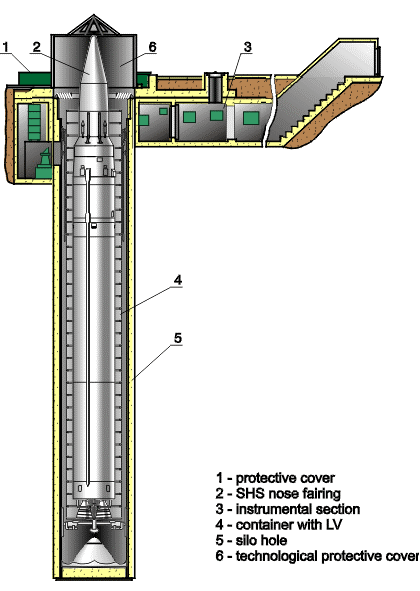Strela Launch Vehicle
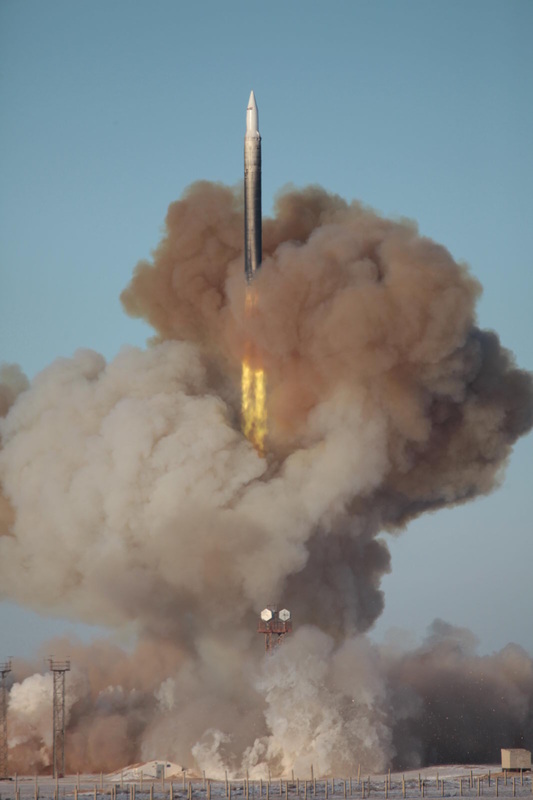
The Strela launch vehicle, like the Rockot launcher, is a Russian orbital launch system capable of lifting light and medium payloads to low Earth orbits.
It is based on the UR-100N Intercontinental Ballistic Missile, also known as SS-19 Stiletto. Development of the UR-100N started in 1970 to improve the UR-100 ICBM by developing a larger missile that could lift heavier payloads. Flight testing was carried out between 1973 and 1975 and the system became operational in 1974. By 1978, a total inventory of 190 launchers was reached. An improved version, called UR-100UTTKh became operational in 1979 and started to replace older missiles, reaching a maximum inventory of 360 rockets.
UR-100 missiles could carry up to six multiple independently targetable reentry vehicles with an operational range of 10,000 Kilometers. The missiles could be readied for launch within 25 minutes at any point in their 22-year storage life. UR-100 ICBMs are still in service today.
After the Cold War ended, the UR-100 missiles were re-purposed by Khrunichev State Research and Production Center to be equipped with modern avionics and Briz-KM Upper Stages to serve as Rockot space launch vehicles. NPO Mashinostroyenia (NPO Mash) also re-purposed the UR-100 to serve as launch vehicle, but without the amount of modifications – creating a less flexible, but much cheaper rocket for small payloads going into Low Earth Orbit. In that configuration, the vehicle is known as Strela.
While Rockot received international support that allowed it to make its first test launch in 1990 and its first orbital flight in 1994, Strela had to wait much longer for its first mission.
Its first flight came in 2003 after years of delays. The mission carried a mock-up of the Kondor satellite to a 404 by 465-kilometer orbit with an inclination of 67 degrees. Following the successful test launch, Strela was on the market for launches, but did not gain any customers. The first ‘operational’ Strela launch occurred in 2013 when the rocket delivered the first real Kondor Satellite to orbit.
While Rockot uses a modified Kosmos 3M Launch Pad, Strela is launched out of the original UR-100 silos. It was planned to launch out of the Svobodny and Baikonur Cosmodrome, but only the Baikonur launch site is still in existence.
Strela Specifications
| Type | Strela |
| Length | 29.2m (SHS-2) |
| Diameter | 2.50m |
| Launch Mass | 105,000kg |
| Stages | 2 (+ APB serving as Upper Stage) |
| Mass to LEO | 1,700kg |
| Mass to SSO | 1,100kg |
Strela is a two-stage liquid-fueled launch vehicle, that uses the SS-19 MIRV-Bus to act as third stage (Multiple Independently targetable Reentry Vehicle) to inject its payloads into the desired orbits.
This simpler design makes Strela less flexible than the Rockot launcher with its re-startable Briz-KM upper stage, but it also leads to a lower launch cost. Strela is suitable for satellite injections into a variety of Low Earth Orbits including circular orbits.
Strela stands 29.2 meters tall (with its long Payload Fairing) and has a main diameter of 2.5 meters. The vehicle has a launch mass of 105,000 Kilograms. Strela can deliver Payloads of up to 1,700 Kilograms into Low Earth Orbit and 1,100 Kilograms into Sun Synchronous Orbit.
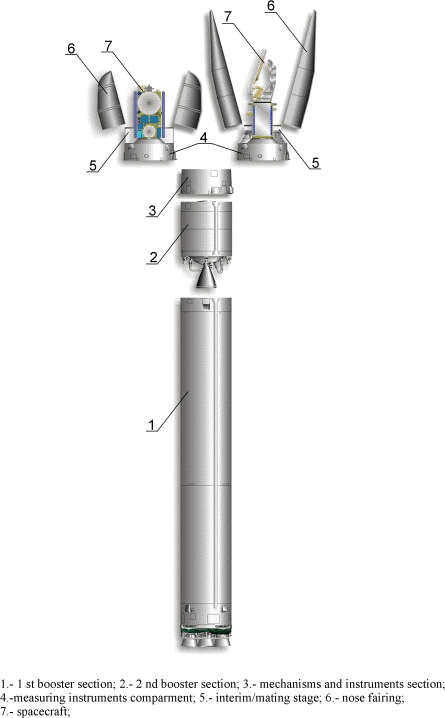
First Stage
| Type | Strela Stage 1 (SS-19 1st Stage) |
| Length | 17.2m |
| Diameter | 2.5m |
| Inert Mass | 5,700kg |
| Launch Mass | 77,200kg |
| Fuel | Unsymmetrical Dimethylhydrazine |
| Oxidizer | Nitrogen Tetroxide |
| Structure | Common Bulkhead |
| Tank Pressurization | Hot Gas System via RD-0234 |
| Propulsion | RD-0232 (3 x RD-0233 1 x RD-0234) |
| Engine Type | Closed-Cycle, Turbopump-fed |
| Total Thrust SL | 1,870kN (Each Engine: 470kN) |
| Total Thrust Vac | 2,070kN (Each Engine: 520kN) |
| Specific Impulse SL | 285s |
| Specific Impulse Vac | 310s |
| Burn Time | 121s |
| Attitude Control | Cardan-Gimbaled Engines |
| Stage Separation | Hot-Staging |
| Max G Force | 7G |
The first stage of the Strela Launcher is 17.2 meters long and 2.5 meters in diameter. It features the common design with the oxidizer tank containing NTO located above the fuel tank that is filled with UDMH. The two tanks share a common bulkhead to separate fuel from oxidizer. Stage 1 Liftoff mass is 77,200kg with an inert mass of 5,700kg.
The first stage is powered by an RD-0232 propulsion unit comprised of three RD-0233 Engines and one RD-0234 Engine. The engines are similar in design, but the RD-0234 version includes a gas generator heat exchanger that supplies pressurant gas to the propellant tanks to keep them at proper flight pressure levels throughout first stage flight. All engines are turbopump-fed, closed-cycle engines. Each of the engines provides 470 Kilonewtons of liftoff thrust amounting to a total liftoff thrust of 1,870kN – 190,700 Kilograms. First stage vacuum thrust is 2,070 Kilonewtons (211,100 Kilograms) – 520kN per engine.
First stage control is provided by Cardan-gimbaling the four engines individually. The first stage burns for 121 seconds.
Stage separation between the first and second stage is accomplished in hot staging mode. The vernier engine of the second stage ignites ahead of stage separation. Special hatches on the first stage direct the exhaust of the four vernier nozzles to the outside. Once the pyrotechnic separation mechanism is initiated, the vernier exhaust pushes the spent first stage away to a safe distance for second stage main engine ignition.
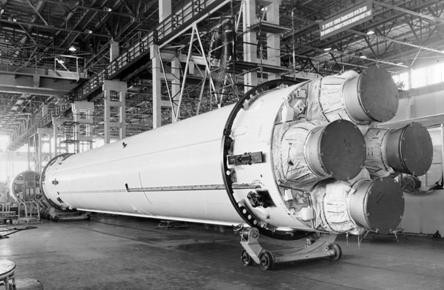
Second Stage
| Type | Strela Stage 2 (SS-19 2nd Stage) |
| Length | 3.9m |
| Diameter | 2.5m |
| Inert Mass | 1,500kg |
| Launch Mass | 12,200kg |
| Fuel | Unsymmetrical Dimethylhydrazine |
| Oxidizer | Nitrogen Tetroxide |
| Structure | Common Bulkhead |
| Tank Pressurization | Hot Gas System |
| Propulsion | RD-0235 (main) RD-0236 (vernier) |
| RD-0235 Thrust Vac | 240kN |
| RD-0235 Chambers | 1 |
| RD-0235 Isp Vac | 320s |
| RD-0235 Burn Time | 183s |
| RD-0236 Thrust Vac | 15.76kN |
| RD-0236 Chambers | 4 |
| RD-0236 Isp Vac | 293s |
| RD-0236 Burn Time | 200s |
| Attitude Control | Gimbaled Verniers |
The second stage of the Strela Launcher is 3.9 meters in length and shares the first stage’s diameter of 2.5 meters. It has an empty mass of 1,500kg carrying 10,700kg of propellants. The NTO oxidizer tank again is located above the UDMH fuel tank and the two are separated by a common bulkhead.
The second stage is powered by a closed-cycle, turbopump-fed main engine called RD-0235 and a four-chamber RD-0236 vernier engine for directional control.
RD-0235 has a nominal vacuum thrust of 240 Kilonewtons (24,470 Kilograms) providing a specific impulse of 320 seconds. The main engine is fed and can not be moved.
The RD-0236 vernier engine provides a total thrust of 15,76 Kilonewtons (1,607 Kilograms) and a specific impulse of 293 seconds. Each of the four nozzles of the vernier engine can be gimbaled along one axis to provide attitude control during second stage flight. Like the first stage, the second stage uses a hot gas system for tank pressurization.
The second stage main engine burns for 183 seconds while the vernier fires for 200 seconds due to the earlier ignition for hot-staging.
.
1-2 Interstage & second stage engine compartment
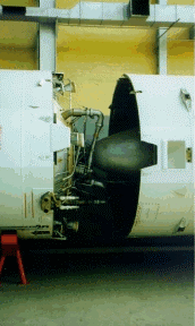
APB Upper Stage
| Type | APB (MIRV Bus) |
| Length | 0.5m |
| Diameter | 2.5m |
| Inert Mass | 725kg |
| Launch Mass | 1,100kg |
| Fuel | Unsymmetrical Dimethylhydrazine |
| Oxidizer | Nitrogen Tetroxide |
| Propulsion | RD-0237 |
| Type | Open Cycle, Pressure-fed |
| Thrust | 4.9kN |
| Specific Impulse | 200s |
| Burn Time | 150s |
As part of the minimal modifications approach of the Strela rocket, the launcher uses a slightly modified UR-100 MIRV bus (Multiple Independently targetable Reentry Vehicle) to inject its payloads into the desired orbits. This module was intended to serve as maneuverable platform to deliver the warheads to their respective targets. This unit, also called APB, has been re-programmed to serve as a small third stage to provide the final push to payloads to reach the target orbit. Atop the APB, a new avionics unit is installed housing the control equipment of the vehicle.
As a minimum upper stage, the APB includes batteries and Flight Control Equipment to perform its burn after a coast phase following separation from the Strela launcher. Following the coast, the APB can perform orbit circularization maneuvers. Because of the low-thrust of the APB, Strela is capable of precise injections with errors smaller than 5 Kilometers in altitude and 0.05 degrees in inclination.
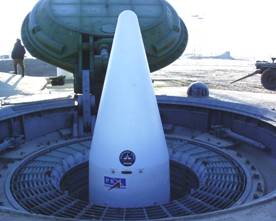
Typical missions feature a nominal ascent by the two-stage rocket followed by a coast phase in a sub-orbital trajectory to allow the vehicle to climb up to the apogee of the trajectory for the APB maneuver that then raises the perigee to an orbital or circular altitude.
The APB is 2.5 meters in diameter and 0.5 meters long. Given its heritage, it has a high dry mass of 725 Kilograms and carries a rather light propellant load of just 375 Kilograms of Unsymmetrical Dimethylhydrazine and Nitrogen Tetroxide. The APB is outfitted with an RD-0237 engine which is a pressure-fed open cycle engine that provides 4.9 Kilonewtons (500 Kilograms) of vacuum thrust, delivering a specific impulse of 200 seconds. APB burn time and burn placement is mission specific, but usually on the order of 150 seconds.
Payload Fairing
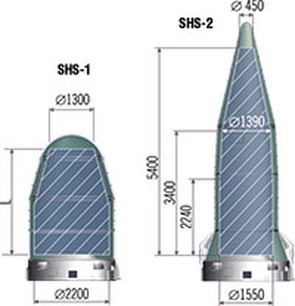
| Fairing Type I | SHS-1 (Regular UR-100) |
| Length | 3.5m |
| Diameter | 2.4m |
| Envelope | 2.2 by 2.9m |
| Fairing Type II | SHS-2 |
| Length | 6.5m |
| Diameter | 1.75m |
| Envelope | 1.55 by 5.0m |
| Structure | Metal sheets & ribs |
| Separation | T+170s |
| Note | Attached to Interim Stage |
The Strela launch vehicle can be outfitted with two different payload fairings to accommodate different sized and shaped spacecraft, however, due to its inflexible design, Strela is only suited for smaller payloads.
The standard UR-100 warhead fairing is available for use aboard Strela being 2.4 meters in diameter and 3.5 meters in length with a usable payload envelope of 2.2 by 2.9 meters. In addition, Strela can be outfitted with a ‘stretched and narrow’ payload fairing which is 6.5 meters long and 1.75 meters in diameter with a usable envelope of 1.55 by 5.0 meters.
Both fairings are similar in construction, consisting of two halves that are manufactured from metal sheets and feature internal longitudinal and transversal ribs to add stability. Thermal insulation material can be applied o the fairing to meet payload requirements. Fairing separation occurs at an altitude of about 120 Kilometers about 170 seconds into the flight. Separation is accomplished by pyrotechnic systems.
SHS Fairing Versions
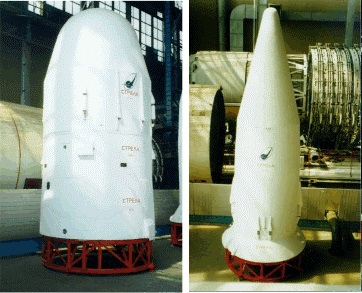
Measuring Instrument Compartment
One of the biggest modifications featured on Strela is the Measuring Instrument Compartment that is located on top of the APB. It was specially developed for the Strela launcher. The unit is 2.4 meters in diameter and 0.8 meters long. It includes a telemetry measurement system and transmitters, a tracking system, the emergency cutoff system for the 1st and 2nd stage, an attitude control system for coast phases, batteries and power supplies as well as the payload adapter that interfaces with the satellite.
Strela Launch Silo
